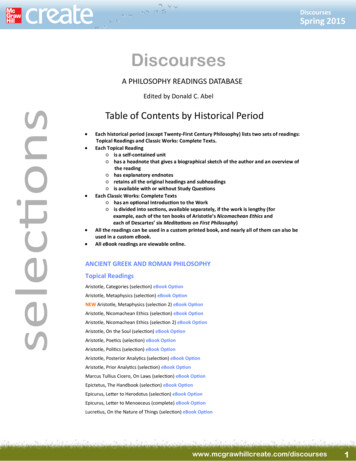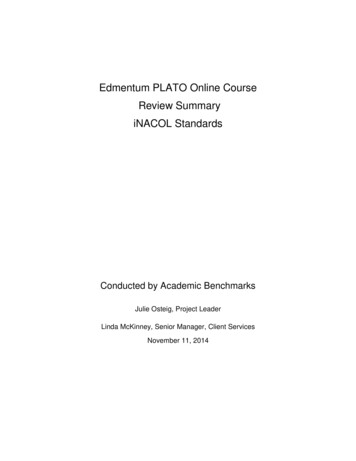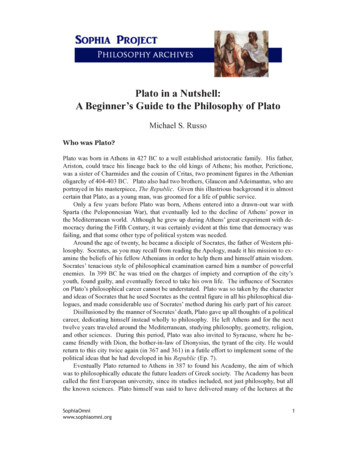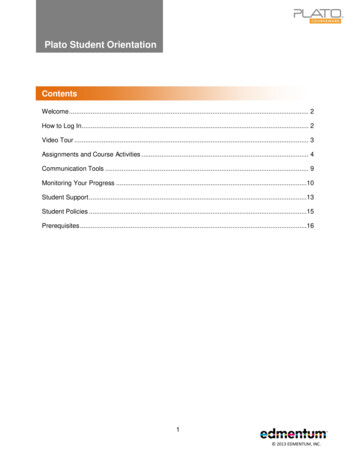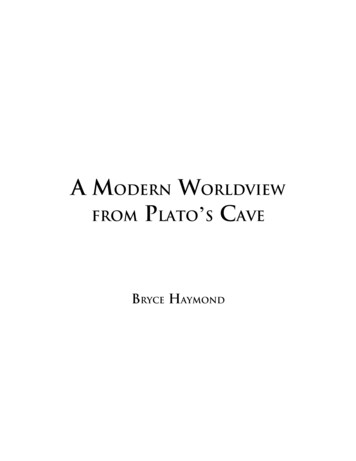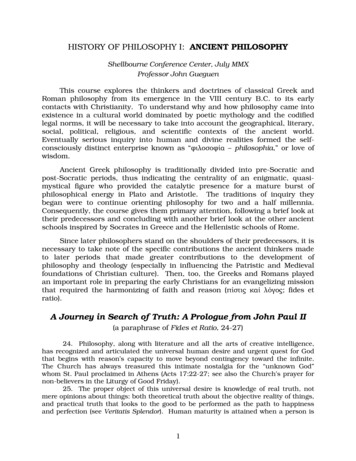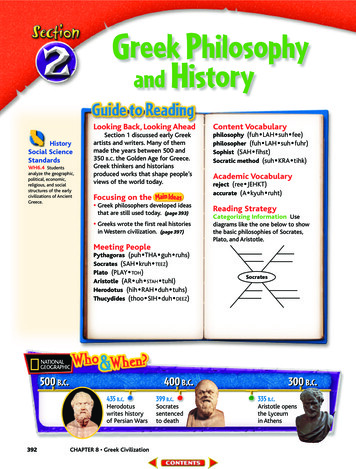
Transcription
P L AT O A N D T H E C R E AT I O NOF THE HEBREW BIBLEPlato and the Creation of the Hebrew Bible for the first time compares the ancientlaw collections of the Ancient Near East, the Greeks and the Pentateuch to determine the legal antecedents for the biblical laws. Following his 2006 work, Berossusand Genesis, Manetho and Exodus, Gmirkin takes up his theory that the Pentateuch was written around 270 BCE using Greek sources found at the Great Libraryof Alexandria and applies this to an examination of the biblical law codes.A striking number of legal parallels are found between the Pentateuch andAthenian laws, specifically with those found in Plato’s Laws of ca. 350 BCE. Constitutional features in biblical law, Athenian law and Plato’s Laws also containclose correspondences. Several genres of biblical law, including the Decalogue,are shown to have striking parallels to Greek legal collections, and the synthesisof narrative and legal content is shown to be compatible with Greek literature.This evidence points to direct influence of Greek writings, especially Plato’sLaws, on the biblical legal tradition. Finally, it is argued that the creation of theHebrew Bible took place according to the program found in Plato’s Laws for creating a legally authorized national ethical literature, reinforcing the importance ofthis specific Greek text to the authors of the Torah and Hebrew Bible in the earlyHellenistic Era.This study offers a fascinating analysis of the background to the Pentateuch andwill be of interest not only to biblical scholars but also to students of Plato, ancientlaw and Hellenistic literary traditions.Russell E. Gmirkin is a writer, researcher, and Dead Sea Scrolls scholar livingin Portland, Oregon. He is the author of Berossus and Genesis, Manetho andExodus: Hellenistic Histories and the Date of the Pentateuch (2006).
COPENHAGEN INTERNATIONAL SEMINARGeneral Editors: Ingrid Hjelm and Thomas L. Thompsonboth at the University of CopenhagenEditors: Niels Peter Lemche and Mogens Müller,both at the University of CopenhagenLanguage Revision Editor: James West at the QuartzHill School of TheologyAvailable:REPRESENTING ZIONFrederik PoulsenMYTHS OF EXILEEdited by Anne Katrine De Hemmer Gudme and Ingrid HjelmREWRITING PETER AS AN INTERTEXTUALCHARACTER IN THE CANONICAL GOSPELSFinn DamgaardSYRIA-PALESTINE IN THE LATE BRONZE AGEEmanuel PfohBIBLICAL INTERPRETATION BEYOND HISTORICITYEdited by Ingrid Hjelm and Thomas L. ThompsonHISTORY, ARCHAEOLOGY AND THE BIBLEFORTY YEARS AFTER “HISTORICITY”Edited by Ingrid Hjelm and Thomas L. ThompsonForthcoming:THE JUDAEO-KARAITE RECEPTIONOF THE HEBREW BIBLEJoshua A. Sabih
P L AT O A N D T H EC R E AT I O N O F T H EHEBREW BIBLERussell E. Gmirkin
First published 2017by Routledge2 Park Square, Milton Park, Abingdon, Oxon OX14 4RNand by Routledge711 Third Avenue, New York, NY 10017Routledge is an imprint of the Taylor & Francis Group, an informa business 2017 Russell E. GmirkinThe right of Russell E. Gmirkin to be identified as author of this work has beenasserted by him in accordance with sections 77 and 78 of the Copyright, Designsand Patents Act 1988.All rights reserved. No part of this book may be reprinted or reproduced orutilised in any form or by any electronic, mechanical, or other means, nowknown or hereafter invented, including photocopying and recording, or in anyinformation storage or retrieval system, without permission in writing from thepublishers.Trademark notice: Product or corporate names may be trademarks or registeredtrademarks, and are used only for identification and explanation without intent toinfringe.British Library Cataloguing-in-Publication DataA catalogue record for this book is available from the British LibraryLibrary of Congress Cataloging-in-Publication DataNames: Gmirkin, Russell E., 1954– author.Title: Plato and the Creation of the Hebrew Bible / Russell E. Gmirkin.Description: First edition. New York : Routledge, [2016] “2016 Series:Copenhagen international seminar Includes bibliographicalreferences and index.Identifiers: LCCN 2016002737 ISBN 9781138684980 (hardback :alk. paper) ISBN 9781315543581 (ebook)Subjects: LCSH: Middle Eastern literature—Relation to the OldTestament. Bible. Old Testament—Comparative studies. Bible. OldTestament—Criticism, interpretation, etc. Plato. Philosophy and religion.Classification: LCC BS1184 .G55 2016 DDC 221.6—dc23LC record available at http://lccn.loc.gov/2016002737ISBN: 978-1-138-68498-0 (hbk)ISBN: 978-1-315-54358-1 (ebk)Typeset in Times New Romanby Apex CoVantage, LLC
tion12Athenian and Pentateuchal legal institutions93Biblical, Ancient Near Eastern and Greek laws734Greek and Ancient Near Eastern law collections1835Greek and biblical legal narratives2206The creation of the Hebrew Bible250Index of referencesIndex of authors301334v
ACKNOWLEDGMENTSMany thanks to all those who helped at every stage in the writing of this book: toThomas L. Thompson, who suggested that I look into the biblical parallels withPlato and other Greek writers cataloged by Philippe Wajdenbaum; to Joann Pattyof the Beaverton Public Library for chasing down my never-ending interlibraryloan requests for exotic sources not found in Portland university holdings duringthe investigative phase; to my lovely wife Carolyn Tracy, the brilliant daughterof local detective Edward “Skip” Tracy, for her many penetrating insights intoPlato’s dark psychology; to both Carolyn and my son Michael for encouragementduring the intensive research and writing phases; to all the friendly employees ofStarbucks for allowing me to write major portions of this book in a pleasant andhighly caffeinated environment; to both Greg Doudna and Philippe Wajdenbaumfor their valuable critical insights and editorial suggestions during the proofing ofthis manuscript; to both Greg Doudna and Daniel Samson for convincing me ofthe need to disseminate the results of my research outside of academia proper andlaying out strategies to do so; and once again to my editor, Thomas L. Thompson, for accepting this long-awaited study as part of the Copenhagen InternationalSeries and for helping to streamline the manuscript with his keen editorial suggestions, bringing the project full circle.vi
A B B R E V I AT I O N SABAJAAJPANET aHLHSCPHTRHUCAIEJJAOSJBLJCSJEAJHSJNESAnchor BibleAmerican Journal of ArchaeologyAmerican Journal of PhilologyAncient Near Eastern Texts Relating to the Old Testament. Editedby James Bennett Pritchard. 3rd ed. Princeton, NJ: PrincetonUniversity Press, 1969.Ante-Nicene FathersAlter Orient und Altes TestamentAncient Records of Assyria and Babylonia. D. Luckenbill. 2 vols.Chicago: University of Chicago Press.American Schools of Oriental Research BooksBiblical ArchaeologistBulletin of the American Schools of Oriental SocietyBeihefte zur Zeitschrift für die alttestamentliche WissenschaftcircaClassical QuarterlyFelix Jacoby, Fragmente der Griechischen Historiker. 15 vols.Berlin: Wiedmannsche Buchhandlung, 1923–1969.Greece and RomeGreek, Roman and Byzantine StudiesHistoria: Zeitschrift für Alte GeschichteHittite LawsHarvard Studies in Classical PhilologyHarvard Theological ReviewHebrew Union College AnnualIsrael Exploration JournalJournal of the American Oriental SocietyJournal of Biblical LiteratureJournal of Cuneiform StudiesJournal of Egyptian ArchaeologyJournal of Hellenic StudiesJournal of Near Eastern Studiesvii
A B B R E V I AT I O N ish Quarterly ReviewJournal for the Study of the Old Testament, Supplement SeriesJournal of Theological StudiesLoeb Classic LibraryLaws of EshnunnaLaws of HammurabiLaws of Lipit-IshtarNeo-Babylonian LawsLaws about Rented OxenLaws of Ur-NammuLaws of XMiddle Assyrian LawsMiddle Assyrian Palace DecreesNew Revised Standard VersionThe Old Testament Pseudepigrapha. Edited by J. Charlesworth.2 vols. New York: Doubleday, 1983.PAAJRProceedings of the American Academy for Jewish ResearchSAAState Archives of AssyriaSBLSociety of Biblical LiteratureSBLDSSBL Dissertation SeriesSBLSymp SBL Symposium SeriesSJOTScandinavian Journal of the Old TestamentSLExSumerian Laws Exercise TabletSLHFSumerian Laws Handbook of FormsSTStudia TheologicaTADTextbook of Aramaic Documents from Ancient Egypt: NewlyCopied, Edited and Translated into Hebrew and English. Editedby B. Porten and A. Yardeni. 4 vols. (A–D). Jerusalem: HebrewUniversity, 1986–1999.TAPATransactions of the American Philological AssociationTAPhATransactions and Proceedings of the American PhilologicalAssociationTAPhSTransactions of the American Philosophical SocietyVTVetus TestamentumVTEVassal Treaty of EsarhaddonVTSupVetus Testamentum, Supplement SeriesWAWSBL Writings from the Ancient WorldZAZeitschrift für AssyriologieZAWZeitschrift für die Alttestamentliche Wissenschaftviii
1INTRODUCTIONThis book is a sequel to Berossus and Genesis, Manetho and Exodus: HellenisticHistories and the Date of the Pentateuch, in which literary source-critical methodswere brought to bear on the timeworn questions of date, provenance and authorship of the Pentateuch (Gmirkin 2006). I there argued an extensive use of theBabylonian historian Berossus (278 BCE) by the authors of Gen. 1–11 and the useof the Egyptian historian Manetho (ca. 285–280 BCE) by the authors of the Exodusstory. Using this and similar data, I inferred that the Pentateuch was written ca.270 BCE,1 drawing on a variety of sources written in Greek and housed in the GreatLibrary of Alexandria. This in turn led to the conclusion that the authors of thePentateuch were the same group of seventy aristocratic, Greek-educated Jewishscholars that ancient tradition credited with having translated the Pentateuch intoGreek at Alexandria at almost exactly the same time (ca. 273–269 BCE). Berossusand Genesis thus laid out a methodological and historical framework in which thePentateuch could be understood as an early Hellenistic Era composition that drewon earlier sources written in Greek.The current study deals with similar themes, considering the possibility thatboth the Pentateuch and the Hebrew Bible as a whole drew on the writings ofPlato found at the Great Library of Alexandria. This hypothesis is explored viatwo lines of argument: that the Pentateuch’s law collections, despite containinga few laws of Ancient Near Eastern origin, are in large part based on Athenianlaw and on Plato’s Laws (Chapters 2–5), and that the Hebrew Bible as a literarycollection was based on instructions found in Plato’s Laws for creating a nationalliterature (Chapter 6).1. Greek comparative studiesExternal evidence does not exclude either a Hellenistic Era date or substantialGreek influence on the biblical text. This indicates that comparative studies withbiblical literature may legitimately include the Greek world and that there is nocompelling reason to exclude either Hellenistic Era cultural features or literaturefrom such studies.1
INTRODUCTIONVarious studies from the early twentieth century to the present explored evidencefor ancient cultural contacts between the Greek world and Ancient Near East,including the Jews. The existence of some sort of cultural interchange betweeneast and west in the Greek Archaic Era or earlier seems beyond dispute. Thepenetration of Near Eastern culture in the Greek world is demonstrated througheastern material remains found in Mediterranean archaeological sites,2 similarinstitutions and customs3 and numerous eastern traditions that were adopted inGreek mythology and literature.4 Phoenician trade in the west is thought to havebeen a key mechanism by which eastern wares and ideas spread across the Mediterranean.5 Similarly, there is archaeological evidence for the penetration of Greekmaterial culture into the east in sites along the Levantine coast from Cilicia tothe Egyptian delta from the Mycenaean era to the fourth centuries BCE, and directGreek contacts with traders living at Dor, Akko and other coastal locations mayhave provided opportunity for the exposure of Phoenicians and others to Greekinfluences.6 Literary, inscriptional and archaeological evidence suggests Greekmercenaries were employed in Cilicia, Ashdod, Egypt and in the Judean Negevin pre-Hellenistic times.7 Literary and inscriptional sources also document military clashes and diplomatic contacts between Greeks and Persians leading up toAlexander’s conquests.8 However, there is little evidence that these contacts ledto the flow of Greek ideas into the Ancient Near East. After the conquests of Alexander the Great, however, Greek influences in the east are well documented anduncontroversial.Contacts between Greek and biblical laws have been commented on fromGraeco-Roman antiquity to modern times.9 Such legal parallels have raised questions regarding the direction of influence, the relative chronology of Greek andbiblical legislation and the circumstances under which Greek and Jewish culturalexchanges could have taken place (Gmirkin 2014: 56–60). In classical antiquity,such points of comparison were explained as evidence of Greek plagiarism ofMosaic law,10 a theory still advocated in some circles as late as the mid-nineteenthcentury (see Gmirkin 2014: 57 and literature cited there). This model becameincreasingly difficult to reconcile with chronological schemes proposed underhigher criticism, in which the emergence of biblical law took place contemporarywith similar developments in Archaic and Classical Greece, not centuries earlieras in a pre-critical reading of the biblical text. Twentieth-century comparisonsbetween Greek and biblical laws no longer suggested direct Greek exposure tobiblical literature, a simplistic model that failed to meet modern critical standards.Finding a satisfactory alternative explanation for Greek and biblical legal parallels posed a considerable ongoing problem.Greek comparative studies, once a favorite topic of research among biblicalscholars versed in Classical literature, were largely eclipsed in the early twentieth century in favor of Ancient Near Eastern literary and cultural comparisons,where the relative chronological priority of biblical and extra-biblical traditionswas easily established. In Ancient Near Eastern comparative studies in the aftermath of the 1902 publication of the Hammurabi Law Code, biblical influence2
INTRODUCTIONfrom antecedent cultures and legal traditions were fully acknowledged. Theories that posited Ancient Near Eastern influence on the biblical law collectionsposed no chronological difficulties, because the Old Babylonian collectionssuch as LE and LH predated the biblical monarchy and the first biblical lawcodes by hundreds of years. Theories regarding possible Greek influence on thebiblical law collections were more problematic under higher criticism, becausecomparable Greek legislation was a phenomenon of the seventh to the fourthcenturies BCE, contemporary with or later than the biblical laws codes undereither the older documentary theories of higher criticism or recent redactioncritical models.Nevertheless, modern scholars of ancient legal systems kept noting contactsbetween Greek and biblical legal traditions. The existence of shared Greek andJewish legal traditions was difficult to accommodate under a view in which thebiblical law collections were believed to have been created prior to the arrival ofthe Greeks in the east. Points of comparison between Greek and Jewish historiography, prophetism and other cultural and literary institutions were similarlyproblematic. As a result, various strategies were employed to explain Greek legaland literary features in biblical literature in pre-Hellenistic times. Purely typological parallels came under increasing disparagement in comparative studies, andproperly so.11 Instead, comparative studies came to be viewed as methodologically valid only if the cultures or literatures being compared were within the same“historical stream,” that is, if the societies under comparison were in geographicalproximity and sufficiently close in time to allow for a direct or mediated flowof ideas.12 A major difficulty in applying this approach to Greek comparativestudies was that possible influences were artificially restricted to the historicalperiod when Samaria and Judah were kingdoms or provinces within the AncientNear East, prior to Alexander’s conquests of the east and the first major contactsbetween Greeks and Jews.13The problem of apparent Greek legal and literary influences on biblical writings prior to arrival of the Greeks in the east met with a variety of explanations.14 One solution commonly posed by authors of comparative studies was toposit an intermediary group who communicated Greek ideas to the east. Suchproposals included Greek and Cretan troops allegedly employed by the biblical King David (Weinfeld 1993),15 Greek mercenaries stationed in the Negevduring the late Judean monarchy (West 1997: 617, among other modes of transmission), Phoenicians (Van Seters 1983: 53–4; Israel was characterized as an“inland Phoenician culture” in Brown 1995, 2000, 2001) or Philistines (Garbini1988: 85–6). Direct contacts between the educated elites of the Greek and Jewish worlds in archaic times prior to the conquests of Alexander the Great, orthe conveyance of Greek writings to Jewish readers and thinkers, even by wayof intermediaries, has never been seriously proposed. The idea that complexlegal notions and sophisticated literary traditions were communicated from theGreek world into the hinterlands of Judah or Samaria16 by way of mercenaries stationed in desert border fortresses or merchants engaged in trading Greek3
INTRODUCTIONpottery and other wares also appears unlikely.17 It is difficult to visualize thesehypothetical intermediaries serving as a channel for the required flow of ideasin the historical stream.An alternative method for accommodating Greek influences on biblical literature in archaic times was proposed by the great legal scholar Raymond Westbrook.Taking for granted that some communication between east and west must haveanciently existed, based on inferences from similar laws found among the Greeks,Romans, Hittites, Babylonians, Assyrians and in biblical legal writings, Westbrook hypothesized a shared Eastern Mediterranean legal culture that embracedall these legal traditions.18 In effect, Westbrook claimed that Archaic and ClassicalGreece and the Ancient Near East were within the same historical stream, despitethe lack of geographical proximity and without specifying a mechanism for thecommunication of ideas. Although Westbrook’s idea of a shared legal culture metwith a variety of criticisms by his contemporaries, it served to legitimize ongoingresearch into shared legal traditions and has been adopted in recent years by severalbiblical researchers engaged in productive comparative studies using Greek legalmaterials (Hagedorn 2004: 43–53, 60–2; Knoppers and Harvey 2007: 105–41). Amajor methodological flaw in Westbrook’s theory is that to a significant degreeit rested on shared Greek and biblical legal traditions that were assumed, but notproven, to have existed deep in archaic times, but which may in fact have firstappeared in biblical literature of the Hellenistic Era, a possibility never envisionedby Westbrook. This circularity in Westbrook’s reasoning both relied upon and wasused to support a dating of biblical legal tradition contemporary with Archaic andClassical Greece. Although an intersection of Greek and biblical legislation canscarcely be doubted today, it may be questioned whether the mechanism for thisshared legal tradition was the common East Mediterranean culture hypothesizedby Westbrook and whether the communication of Greek legal values, institutionsand laws to the biblical authors took place prior to Alexander’s conquests and theHellenization of the east as Westbrook assumed.2. The current volumeThe first reliable external evidence for the composition of the Pentateuch is theSeptuagint translation at Alexandria ca. 270 BCE (Gmirkin 2006: 34–88; Gmirkin2014), well into the Hellenistic Era. The current volume therefore adopts the position that comparative methods used to illuminate the biblical text should includeGreek literature and cultural institutions from the Classical and early Hellenistic Eras alongside those of the Ancient Near East. In Chapters 2–5, a systematiccomparison will be made among biblical, Greek and Ancient Near Eastern legaltraditions.19 Striking parallels will be shown to exist between biblical and Greekconstitutional and social institutions (Chapter 2), laws (Chapter 3), law collections (Chapter 4) and legal narratives (Chapter 5) that are for the most part absentfrom Ancient Near Eastern legal tradition. Many of these points of comparisonshow a special relationship between biblical and Athenian laws and institutions as4
INTRODUCTIONwell as those described in Plato’s Laws. Such parallels are exceedingly difficultto explain under the hypothesis that biblical legal traditions developed in the Persian Era or earlier, when direct Athenian influence on Jewish legal writings canbe ruled out, even under the theory of an Eastern Mediterranean cultural sphere.However, Jewish access to the legal collections found in the Great Library ofAlexandria provides a direct mechanism whereby the biblical authors could havebecome familiar with both Athenian laws and with Plato’s Laws. In Chapter 6, itis further argued that the Hebrew Bible as a whole was created in the third centuryBCE under the influence of Plato’s Laws, which featured instructions for creating anational library of approved texts with ethical content (§§ 1–2), and that the Jewish theocracy historically established in the early Hellenistic Era was directly patterned on the novel form of government under divine laws also laid out in Plato’sLaws (§§ 4–6). A picture emerges in which Plato’s Laws, which described how toestablish a new government with its constitution, laws and other institutions, hada decisive influence on the refounding of the Jewish nation and the creation of itsnational literature ca. 270 BCE.Notes1 More accurately, the Pentateuchal dating arguments from Berossus and Genesis pointto a definite date of 278–269 BCE and a likely date of 273–272 BCE. See chart at Gmirkin2006: 245. For convenience of reference, this book will abbreviate the date of composition to ca. 270 BCE.2 See especially Burkert 1992; cf. Astour 1967: 323–57.3 Points of commonality include similar conceptions of divine kingship, common elements in oaths and treaties and common sacrificial and divinatory practices. See Burkert 1992: 41–87; West 1997, especially 14–23, 41–2; Launderville 2003.4 See discussions in the sources from the preceding footnote. Specialized discussions ofeastern influences on Hesiod and Homer include Gordon 1955: 43–108; Walcot 1966;Penglase 1994; Morris 1997; Louden 2011.5 West 1997: 606–24. Greek contacts with eastern craftsmen located in Crete played ahypothesized role in the spread of Ancient Near Eastern legal traditions to the Greeksand Romans in Mühl 1933. Evidence Mühl cited for his theory of early legal contactsbetween east and west included the existence of written law collections in Greece andRome; the existence of an early Roman law of lex talionis that later sources attributedto either Zaleucus of Locri in ca. 660 BCE (Demosthenes, Against Timocrates 140–1) orCharondas of Catana in ca. 675 BCE (Diodorus Siculus, Library 12.17.4–5); and certainother laws shared by Greeks, Romans and the biblical authors. For a critique of Mühl’stheories, and especially of the hypothesized role of Cretan craftsmen in propagatingwritten law collections to the Greek world, see Gagarin 1986: 62.6 See Waldbaum 1997; Niemeier 2001. Evidence for a Greek settlement at Al Mina innorthern Syria is no longer considered supported by archaeological evidence. Unambiguous Greek remains in Syria appear to be limited to pottery: Greek temples (exceptperhaps at Tall Sukas) or other architectural remains or Greek burial sites have not beendiscovered. Greek lettering on pottery appears the best evidence for Greek presence inthe Levant. The establishment of a Greek trading post at Naucratis in the Egyptian deltain ca. 620 BCE is well known from historical sources.7 Niemeier 2001: 16–24. See Herodotus, Histories 2.152–54; Diodorus Siculus, Library1.66–67 for the employment of Carian and Ionian mercenaries by Psammetichus I.5
INTRODUCTION8 See Kuhrt 2007: 1–417 for Greek political and military contacts with the Persians. InKuhrt’s exhaustive survey of the primary sources, the lack of detectable Greek influences on Persian literature, culture or notions of legislation is striking.9 Legal parallels were noted in passing in Josephus, Apion 2.151–286 and systematicallyat Eusebius, Preparation for the Gospel 12.35–47.10 Jewish and Christian claims for the priority of Moses and biblical literature were discussedin Droge 1989. Such claims were made by the Jewish writers Eupolemus, Aristobulus,Philo and Josephus; the Church Fathers Justin Martyr, Tatian, Clement of Alexandria,Origen, Eusebius and Augustine; and “pagan” authors such as Numenius of Apamea.11 The iconic example of broad, typological comparisons between cultures with no geographical or historical contact was Frazer 1911–15. Such erudite but uncritical comparative studies came under criticism in various influential discussions on comparativemethodology, including Sandmel 1962; Malul 1990; Talmon 1991. Noth’s theory ofan Israelite amphictyonic league during the Judges period (Noth 1966) was eventuallyrejected, among other reasons, for its unsound typological comparisons with much laterGreek institutions.12 Malul 1990: 13–18, 89–91, 99–101; Talmon 1991: 386. Malul contrasted the “historical comparative approach,” in which an effort is made to demonstrate a sharedhistorical stream and inter-cultural flow of ideas, with the “typological comparativeapproach,” which is satisfied with cataloging parallels.13 This bias is illustrated in Malul 1990: 19–85, where an Ancient Near Eastern background to biblical laws was assumed throughout.14 See Kuhn 1996: 77–91, on coping strategies employed by those who have inherited aresearch paradigm to eliminate apparent contradictions posed by conflicting or anomalous data.15 Weinfeld 1993: 1–2 argued that the genre of foundation story independently aroseamong the Greeks and Israelites because both were “based on colonization and founding of new sites,” unlike the “autochthonous cultures” of the great Ancient Near Eastern empires, where this genre was entirely unknown. Weinfeld dubiously sought tobolster this model by arguing for a historical basis for the Exodus and Conquest traditions (1993: 41–51). Weinfeld believed that the foundation stories “crystallized inthe Davidic period, when there were contacts with elements originating in the Greeksphere, such as Krethi and Plethi” (1993: 2). This thesis appears to involve anachronisms, because the Greek colonization movement and the genre of foundation story areto be dated in the eighth century BCE (Malkin 1987: 262–6). A better explanation forthe literary parallels is the direct influence of Greek literature on the formation of thebiblical text in the Hellenistic period.16 Josephus, seeking to explain the fact that Greek literature took no notice of the Jewsand Jewish literature took no notice of the Greeks, noted that the Greeks knew mainlyabout coastal people with whom they had trade contacts, whereas the ancestral landsof the Jews were located inland from the sea and isolated from international commerce(Apion 1.60–68). His observations still appear valid and relevant.17 A key problem unaddressed in proposals of Phoenician or Philistine intermediariesbetween Greeks and Jews is that neither group produced literature or legal traditions ofthe type they are hypothesized to have communicated to the Jews. Nor are such traditions associated with Greek soldiers or merchants anciently residing in the east. Thesocial networks in which legal traditions were discussed and shared in the Greek worldare known to have consisted of highly educated, ruling class elites, as documentedin Classical Greek sources, not tradesmen or military. Osborne (2009) argued fromarchaeological data that neither the creation of new social networks nor a disseminationof Greek culture, practices and learning accompanied the trade in Greek pottery in theMediterranean world.6
INTRODUCTION18 Westbrook’s arguments appeared in a series of articles conveniently assembled in Wellsand Magdalene 2009. In the present volume, I will cite Westbrook’s articles with theoriginal titles, but with page numbers taken from Wells and Magdalene 2009. Westbrook’s theory was critiqued in Greengus 1994: 60–87.19 Literary dependence of some Pentateuchal laws on Plato’s Laws was first argued byKupitz 1997. My own study of Plato’s writings was largely stimulated by the impressive collection of biblical parallels assembled at Wajdenbaum 2011: 158–205. Biblicalparallels to other Greek writers found in Kupitz 1997 and Wajdenbaum 2011 are oftenless convincing.BibliographyAstour, Michael C., Hellenosemitica: An Ethnic and Cultural Study in West Semitic Impacton Mycenaean Greece. Leiden: E. J. Brill, 1967.Brown, John Pairman, Israel and Hellas. 3 vols. BZAW 231, 276, 299. Berlin: De Gruyter,1995, 2000, 2001.Burkert, Walter, The Orientalizing Revolution: Near Eastern Influence on Greek Culturein the Early Archaic Age. Revealing Antiquity 5. Cambridge: Harvard University Press,1992.Droge, Arthur J., Homer or Moses?: Early Christian Interpretations of the History of Culture. Hermeneutische Untersuchungen zur Theologie 26. Tübingen: Mohr, 1989.Frazer, James, The Golden Bough: A Study in Magic and Religion. 12 vols. London: MacMillan, 1911–15.G
Hebrew Bible took place according to the program found in Plato's Laws for cre-ating a legally authorized national ethical literature, reinforcing the importance of this specifi c Greek text to the authors of the Torah and Hebrew Bible in the early Hellenistic Era. This study offers a fascinating analysis of the background to the Pentateuch and


